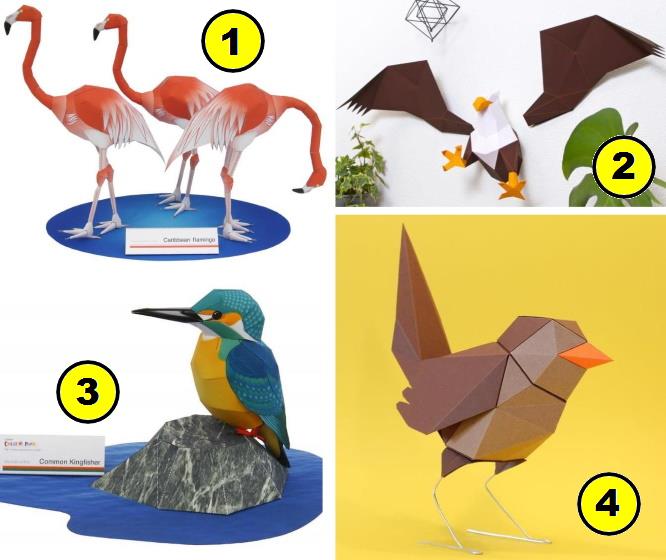Pitholaur is the author of these very nice retro decorative papercrafts inspired by Metroid Fusion, an old Nintendo`s Gameboy Advance game.
You will find, besides the templates (when you visit the site, the link to download them is at the bottom of the page), basic instructions on how to put everything together.
The 3D effect in the frame is achieved by superimposing several layers of paper, each of which presents only some elements of the scene.
In this diorama, for example, we have outer space as the background, then the interior of the ship and further on we have the main characters.
Each layer is purposefully separated by a few millimeters, at most a centimeter, which gives the effect of depth.
You can also install small LED lights of different colors between the layers, which will enhance the 3D effect.
Metroid Fusion is an action-adventure videogame developed and published by Nintendo for the Game Boy Advance in 2002. It was developed by Nintendo Research & Development 1, which had developed the previous Metroid game, Super Metroid (1994).
Players control the bounty hunter Samus Aran, who investigates a space station infected with shapeshifting parasites known as X. Like previous Metroid games, Fusion is a side-scrolling game with platform jumping, shooting, and puzzle elements.
Although in the West this type of craftsmanship is often referred to as a shadow box, the correct term would actually be tatebanko, as while both involve creating relief art within a box, they are not the same thing.
A shadow box is a box with greater depth than a typical frame.
It is commonly used to display three-dimensional objects or collections, such as medals, figurines, dried flowers, among others.
The goal is to create a three-dimensional display within the box, with layers of depth to highlight the objects.
Tatebanko is a traditional Japanese form of paper art. It involves creating three-dimensional scenes within a paper box.
Scenes are crafted with carefully folded paper cutouts layered inside the box to create an illusion of depth.
These scenes often depict landscapes, urban settings, or even scenes from popular Japanese tales.
While both involve creating art within a three-dimensional box, they have different cultural origins and techniques.
The shadow box is more versatile in terms of content and can contain a variety of materials, whereas tatebanko is a more specific paper art form with roots in Japanese tradition.
Tatebanko is a more purist form, allowing only the use of paper in its composition, while the shadow box allows for the use of various types of materials. This is the basic difference between the techniques.
Pitholaur é o autor destes belos papercrafts decorativos retrô inspirado em Metroid Fusion, um antigo jogo do Gameboy Advance, da Nintendo.
Você vai encontrar, além dos templates (quando visitar o site, o link para baixá-los está no final da página), instruções básicas de como colocar tudo junto.
O efeito 3D no quadro é conseguido pela sobreposição de várias camadas de papel, onde cada uma delas apresenta apenas alguns elementos da cena.
Neste diorama por exemplo, temos o espaço sideral como plano de fundo, depois o interior da nave e mais a frente temos os personagens principais.
Cada camada é propositalmente separada por alguns milímetros, no máximo um centímetro, o que dá o efeito de profundidade.
Você também pode instalar pequenas luzes de led de cores variadas entre as camadas, o que potencializará o efeito 3D.
Metroid Fusion é um videogame de ação e aventura desenvolvido e publicado pela Nintendo para o Game Boy Advance em 2002. Foi desenvolvido pela Nintendo Research & Development 1, que desenvolveu o jogo Metroid anterior, Super Metroid (1994).
Os jogadores controlam a caçadora de recompensas Samus Aran, que investiga uma estação espacial infectada com parasitas metamorfos conhecidos como X. Como os jogos Metroid anteriores, Fusion é um jogo de rolagem lateral estilo plataforma, tiros e elementos de quebra-cabeça.
Embora no Ocidente se diga que este tipo de artesanato seja um shadow box, na verdade o correto seria chamá-lo de tatebanko, pois mesmo que ambos envolvam criar arte em relevo dentro de uma caixa, eles não são a mesma coisa.
Um shadow box é uma caixa com uma profundidade maior do que uma moldura comum.
Geralmente é usada para exibir objetos tridimensionais ou coleções, como medalhas, bonecos, flores secas, entre outros.
O objetivo é criar uma exibição tridimensional dentro da caixa, com camadas de profundidade para destacar os objetos.
Tatebanko é uma forma tradicional japonesa de arte em papel. Consiste em criar cenários tridimensionais dentro de uma caixa de papel.
As cenas são elaboradas com recortes de papel cuidadosamente dobrados e colocados em camadas dentro da caixa para criar uma ilusão de profundidade.
Essas cenas muitas vezes retratam paisagens, cenários urbanos ou até mesmo cenas de contos populares japoneses.
Embora ambos envolvam criar arte dentro de uma caixa tridimensional, eles têm origens culturais e técnicas diferentes.
O shadow box é mais versátil em termos de conteúdo e pode conter uma variedade de objetos, enquanto o tatebanko é uma forma de arte em papel mais específica, com raízes na tradição japonesa.
O tetebanko é uma forma mais purista, que permite apenas o uso de papel em sua composição e o shadow box permite o uso de vários tipos diferentes de materiais. Essa é a diferença básica entre as técnicas.
Link: Metroid.Fusion.A.Tatebanko.Decorative.Papercraft.by.Pitholaur
More Tatebankos themed related posts:





























